Take Aim Semi-Independent Format Teacher Responsibilities
Take Aim Semi-Independent Format: Steps
2254 Views
The steps in the Take Aim program use research-supported methods to teach vocabulary words—explicit instruction of target words, instruction of target words in context, student-friendly definitions, multiple exposures and contexts for target words, and semantic mapping.
STEP 1: TAKE UNIT PRETEST AND MARK TARGET GRAPH
 | Each Take Aim level includes 12 themed units. The student begins each unit by taking a timed pretest in which he or she matches the unit's target words with their definitions. The pretest provides a baseline for progress monitoring, showing the number of words the student already knows and the number he or she needs to learn. The student marks his or her score from the pretest on a target graph. |
STEP 2: COMPLETE LESSONS 1–4
Each unit includes four lessons related to the unit's theme. Each lesson teaches six target vocabulary words. Lessons include stories and corresponding vocabulary activities.
 | A. Read the Target Words This pre-reading activity introduces the student to the six target words taught in the lesson. The student reads each target word along with the audio CD as the narrator models correct pronunciation. |
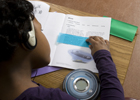 | B. Read the Story The student reads the story along with the audio CD. This step introduces the student to the story while helping him or her learn to read unknown words and encouraging proper pronunciation, expression, and phrasing. |
 | C. Read to Understand Target Words The student reads the story again with the audio CD. During this read-along, three of the lesson's six target words are defined immediately after they appear in the story. Having a word defined immediately after it is encountered in text helps the student gain an understanding of the word in context. |
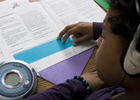 | D. Use Context Clues This mini-lesson points out the context clues around a target word and helps the student use these clues to decipher the target word's meaning. This teaches the student to use the information he or she does know to figure out the meanings of words he or she doesn't know—a strategy that will help the student when he or she encounters unknown words in the future. |
 | E. Read to Understand More Target Words The student reads the story along with the audio CD for a third time. During this read-along, the remaining three target words are defined in context. The student checks whether he or she correctly figured out the meaning of the featured target word in Section D. |
 | F. Read to Master The student practices reading the story orally, without audio support, until he or she can read it well. Reading the story several times helps the student deepen his or her understanding of the target words while building fluency and confidence. |
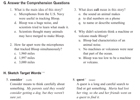 | G. Answer the Comprehension Questions The student answers four multiple-choice comprehension questions about the story and records his or her answers in the student packet. Whenever possible, target words appear in the questions and answer choices to provide additional exposure to these words in context. Answering comprehension questions about the story holds students accountable for meaning and provides teachers with information about how well students comprehend the story. |
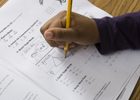 | H. Sketch Target Words For each target word in the lesson, the student reads the definition along with the audio CD. Then, in the student packet, he or she sketches a quick picture or writes a phrase that shows what the word means to him or her. This activity helps tie the student's understanding of the word to his or her personal experience and helps the student remember what the word means. |
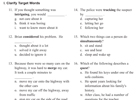 | I. Clarify Target Words The student answers multiple-choice vocabulary questions about each of the lesson's six target words. Whenever possible, these questions go beyond the direct definitions of the target words and require students to use their knowledge of each word's meaning to determine the correct answer. The questions often provide additional insight into the meanings of the words and expose the student to another rich context. These vocabulary questions deepen students' knowledge of the target words and provide teachers with information about how well students understand the meanings of the words. |
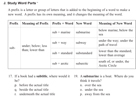 | J. Study Word Parts In the first lesson in each unit, Section J teaches a word part (prefix, suffix, or root). The student listens and responds to the audio CD to learn the root or affix. Then the student answers multiple-choice questions based on that word part and records his or her answers in the student packet. This step teaches the student about word parts and how they provide clues about a word's meaning. |
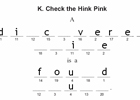 | K. Check the Hink Pink After answering all the questions in the lesson, each student completes a hink pink puzzle on his or her student packet to confirm that the answers to the questions are correct. The student uses answers from Sections G, I, and J to fill in the blanks for the hink pink. If the answers are correct, the hink pink will make sense (i.e., the words in the first part of the sentence will be synonyms for the words in the second part of the sentence, and the words in the second part of the sentence will rhyme). If the hink pink does not make sense, the student needs to go back and redo some of the questions. By completing the hink pink, the student is motivated to check the answers to the questions, and he or she is exposed to synonyms and additional vocabulary words through wordplay. |
 | Enrichment: Apply the Target Words An optional enrichment activity further deepens word learning. The student uses the target words to describe examples or events from his or her own experience. |
 | Lesson Checkout During the lesson checkout, you determine whether a student is ready to move on to the next lesson in the unit. To move on to the next lesson, the student must be able to read the target words aloud, read the story fluently, and define the target words. He or she must also have answered the questions correctly. A correct hink pink usually indicates correct answers. |
STEP 3: COMPLETE UNIT ACTIVITIES
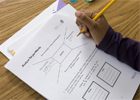 | Analyze Target Words After completing all four lessons in a unit, the student works on semantic mapping activities that use target words. The activities in this section teach the student to associate new words with familiar words and also develop knowledge of synonyms, antonyms, and parts of speech. |
STEP 4: STUDY TARGET WORDS
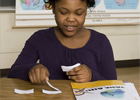 | The student goes back and studies all the target words taught in the unit. To study, the student can use flashcards provided in the student packet, review his or her sketches, or use the glossary to review target words. Studying increases the likelihood that the student will learn the target words and succeed on his or her posttest. |
STEP 5: TAKE UNIT POSTTEST AND MARK TARGET GRAPH
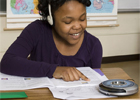 | After studying the target words, the student is ready to take the unit posttest. The posttest is the same as the pretest, but the test items are arranged in a different order. The posttest measures the number of words that the student gained by working through the unit. The student graphs the posttest score on the same graph he or she used to mark the pretest scores. Seeing evidence of progress motivates the student. |
ADDITIONAL UNIT ACTIVITIES (OPTIONAL)
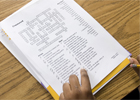 | Additional unit activities are available for extra student enrichment and support. These activities are not required for all students; teachers use their discretion to determine which students would benefit from them. Additional activities include crossword puzzles, an activity that uses questions to pull together ideas from multiple lessons, and an activity that shows relationships between words with the same root. |
Please let us know what questions you have so we can assist. For Technical Support, please call us or submit a software support request.